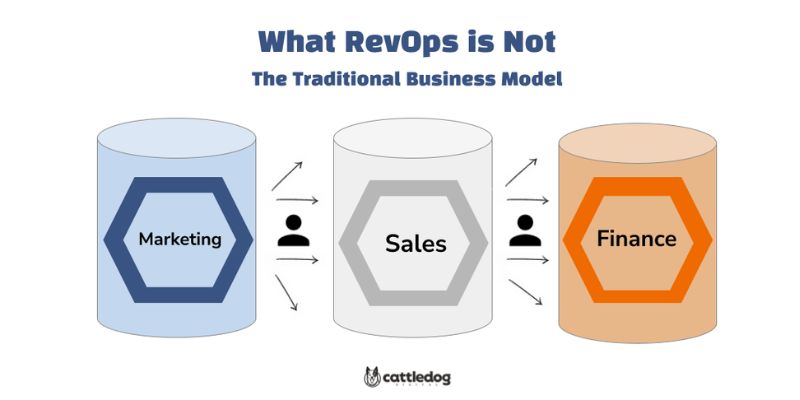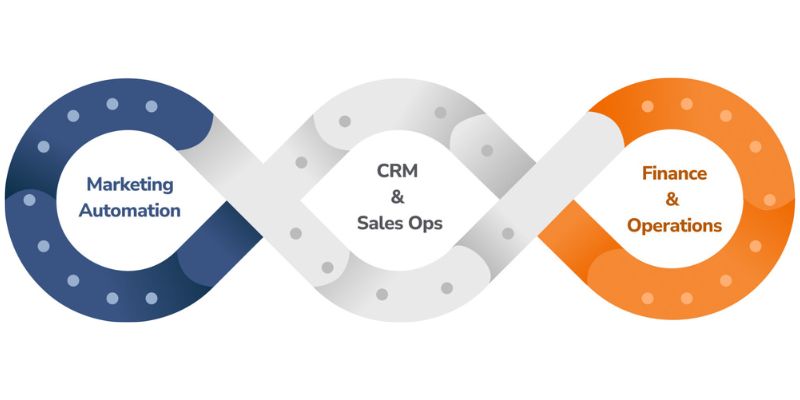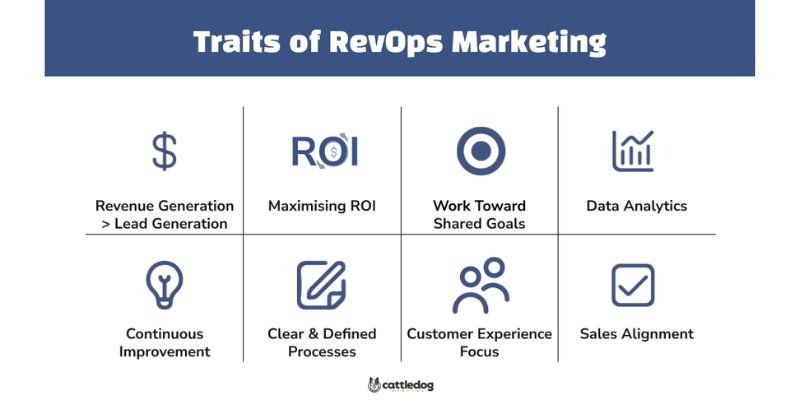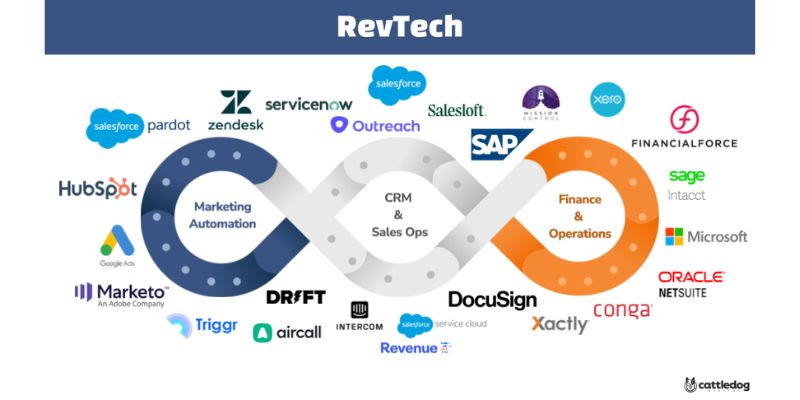Revenue Operations: A RevOps Guide to Who, What, and Why
What is revenue operations (RevOps)?
A revenue operations team can align all your departments and remove any divisions between them. It’s like having a growth partner within or via an outsourced team, for your organization to create harmony and remove some of the digital dysfunction blocking or leaking in your revenue funnel.
Revenue operations across different departments
The concept of revenue operations enables the marriage between all departments toward your revenue and customer goals. A common goal is the first step, and the second step is to ensure all the departments work effectively together.
Sales, marketing, customer service, product, and finance work together effectively. The revenue operations team provides the tools, systems, and underpinning processes to help reach the goal.
At a minimum, sales, marketing, and customer service should collaborate. If you can structure your organization to make the handover of a lead to the sales department seamless, you’ve won half the battle.
Why are revenue operations important?
When all departments within a business are aligned, you can accelerate the output and reduce any revenue leakage.
Without revenue operations, you end up with silos or pockets within the organization, meaning the teams don’t talk to each other. So you may have an incredible sales team and a great marketing team, but they don’t let each other know what they’re up to or what KPIs they are working towards.
Perhaps your marketing team spent all their budget generating leads, but the leads aren’t converting – a prime example of revenue leakage. If you have a RevOps team, they can streamline the processes to minimize that revenue leakage.
What is a successful revenue operations team?
You might already have people working on revenue operations in your business, you just don’t call it that. If sales and marketing teams talk to each other, you’re already on the way to RevOps.
If the systems and tools aren’t talking to each other, you end up with a silo of data that needs to be manually provided, which causes a distrust called digital dysfunction. That digital dysfunction causes revenue leakage in the company. A successful RevOps function doesn’t have this dysfunction.
Calendy has a huge RevOps division, a team of 40 whose sole job is to create collaboration across the different departments and support the technology stack.
What’s the difference between RevOps and SalesOps?
Having a RevOps team is like having a growth partner in your organization. Even if it’s just one person with an operational mind and a growth mindset, they can significantly impact how your teams work together.
Sales operations tend to focus solely on the sales element of the business without much involvement in what other teams are doing.
Where to start with revenue operations?
To get started with revenue operations, you need a clear idea of the issues within your company and what’s currently happening. You could create a backlog of dysfunction or a “matrix of pain” so there’s a clear overview of what needs fixing.
It could be that your leads aren’t converting to sales; why is that? Is it because the handover process isn’t clearly defined? Is it because there’s no clear definition of a qualified lead?
You want to build a system that supports your definition of a qualified lead within your organization. Getting this right avoids any dysfunction with technology before it becomes an issue.
What are the key revenue operations metrics?
You’ll have your pre-qualified lead, marketing-qualified lead, and sales-qualified lead, but the interesting bit is how that lead is passed from team to team. You want the process to be as seamless as possible.
Once the contract is signed, you want the invoice paid as smoothly and quickly as possible.
A big part of RevOps is actually the end of the funnel. There’s a massive opportunity for organizations to make minor tweaks to improve the quote-to-invoice payment process.
What’s the role of technology in revenue operations?
Before relying on technology to help with revenue operations, it’s essential to define the processes and prioritize the problems that need solving.
You shouldn’t be looking to the tech to solve the problem; the tech will amplify the problem. To get the most out of your investment in tech, you need to understand why you want to use it first and how it will affect the rest of the funnel.
Define processes per the priorities, then use tools and technology to help execute or implement those steps.
For the front of the funnel, our recommendations for tech are Triggr, Pendula, Intercom, Drift, Hubspot, Salesforce, and SalesLoft.
In the mid-funnel, you’ll want CSS tools and Salesforce coupled with Conga, potentially Docusign and Mission Control (if you’re in a PS org).
For your CPQ (configure, price, and quote) and revenue recognition stack tools like FinancialForce, which you then put into Salesforce and then BI, can be helpful. There are hundreds of tools to help you with RevOps, and you will choose them based on your needs. This example is our out-of-the-box b2b stack.
What roles do revenue operations involve?
“RevOps isn’t for the faint-hearted! You have to tell people the baby is a bit ugly sometimes.”
To work in a RevOps team, experience with different tech roles is hugely beneficial. There are various roles within the RevOps team, such as:
- Revenue Operations Analyst (average US salary $58k-$62k)
- Revenue Operations Data Manager (average US salary $76k)
- Revenue Cycle Manager (average US salary $92k)
- Director of Revenue Strategy (average US salary $117k)
The size of your RevOps team depends on the size and growth rate of the business. Ultimately, you might be lucky if you’re a small organization and only need 1-2 people whose whole job is to automate the revenue funnel, including the tech stack. Finding the unicorns that get it and have experience operationalizing revenue can be challenging.
If you’re lucky, you’ll turn a salesperson into a content marketer, a marketing person into a salesperson, and customer service will then be able to sell. The less siloed, the better, and everyone in these functions should eventually roll up to the CRO (Chief Revenue Officer) or COO (Chief Operating Officer).
These roles should weave the different org chains together, and then you’d add IT and CRO and extend out the Method Of Procedure and Standard Operating Procedure teams accordingly.
Learn more about RevOps
Want to reduce your revenue leakage and introduce rev ops into your business? Still, trying to figure out where to start? Get talking to one of our RevOps mentors to get on the right path.
Frequently Asked Questions
Revenue operations help align all teams (sales, marketing, customer success, finance) within a company to drive growth and ensure they work towards a common goal.
They analyze customer conversion and retention data and devise strategies to get the marketing and sales teams on the same page. They provide a framework for other functions within the business that will help increase revenue.
RevOps focuses on numerous functions within the company to drive growth; it keeps the teams responsible for revenue accountable. SalesOps concentrates solely on the sales function.
Revenue operations reduce revenue leakage and ensure accountability and synchronicity across all teams within a business. A revenue operations team can help drive predictable revenue and growth.








